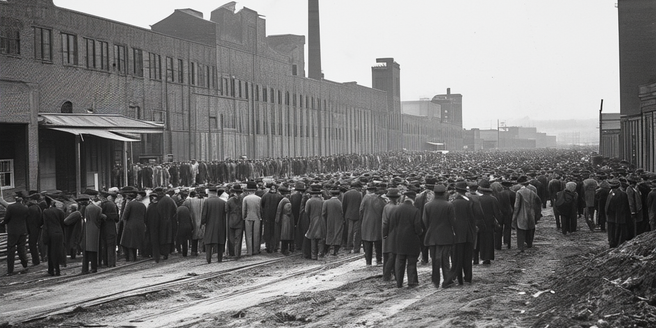The Roots of Unemployment: A Brief History
Unemployment, as we understand it today, is a relatively modern phenomenon. In early societies, work was a shared responsibility and any lack of it was usually due to a scarcity of resources. This was a significant shift; as societies became more complex, so too did the systems of labor and employment. These new social structures brought about new challenges including layoffs and unemployment. With the industrial revolution, the nature of work changed massively. The rise of factories and mass production displaced traditional labor systems. Urbanization resulted in overcrowding, leading to increased competition for jobs and subsequently, unemployment. In the Great Depression of the 1930s, joblessness reached unprecedented level, leading to social unrest and economic upheaval.
Decoding Unemployment Rates: What They Mean And How They’re Calculated
Understanding how unemployment rates are calculated is essential for interpreting their implications. A simple definition of unemployment rate is the percentage of the labor force that is jobless. But it’s not that simple. This calculation also takes into account people who are actively seeking work, not just those who are currently jobless. It is important to note that those who have stopped looking for work, for various reasons, are not included in these calculations. It involves complex statistical theories and measures that are used to quantify this data. Various types of unemployment like cyclical, structural and frictional are considered. Sometimes, the rate might not accurately reflect the actual state of the job market. Therefore, a deeper understanding is required to fully comprehend the nuances of these rates.
Different Types of Unemployment: A Closer Look
Unemployment is a complex situation that varies according to the underlying cause, mainly seen as frictional, structural, and cyclical unemployment, each presenting unique characteristics. Frictional unemployment relates to those in job transitions; it’s a natural occurrence in a dynamic economy and is typically temporary. Structural unemployment, however, stems from the discrepancy between workers’ skills and market demand, often due to technological advancements or industry decline, necessitating interventions like reskilling or reeducation to address the disparity. Cyclical unemployment arises during economic recessions when decreased demand leads businesses to reduce the workforce, necessitating strategies to stimulate economic growth. An understanding of these unemployment forms helps individuals cope with their specific situations and aids policymakers in formulating tailored strategies and policies, thereby allowing for dynamic and successful policies to address unemployment in its many forms.
Unemployment’s Impact on the Economy and Society: The Big Picture
Unemployment is a complex issue that impacts not only personal financial stability but also larger economic structures by slowing growth through disrupted supply and demand cycles. It extends socio-economic consequences, correlating increased joblessness with crime rates, public health declines, and social instability, potentially leading to poverty and unrest. Unemployment’s ripple effect spans individuals, families, communities, and regions, with idle human capital signifying the wastage inherent in high unemployment and inefficient economic dynamics. In the long term, unemployment impacts an economy’s productive output and growth potential, potentially catalyzing stagnation or recession, making minimizing unemployment a core goal in economic policies of all nations.
Mitigating Unemployment: Strategies and Considerations for the Future
Addressing rising unemployment involves meticulous planning and well-thought-out strategies. Reducing structural unemployment, which results from skill mismatch, can be achieved by enhancing the education system and expanding vocational training programs to equip individuals with in-demand skills. Furthermore, managing cyclical unemployment, prevalent during economic downturns, is possible through economic stabilization which helps regulate job market fluctuations. Effective measures that strengthen economic frameworks and recovery plans can improve employment rates. Also, implementing active labor market policies can provide short-term unemployment relief by assisting job seekers and offering subsidized employment. However, addressing unemployment isn’t only about job numbers, but also the quality of jobs which includes fair wage provisions, good working conditions, leading to higher productivity and thus stimulating further job creation. Hence, tackling unemployment requires a multi-pronged approach which focuses equally on the quantity and quality of jobs available.



